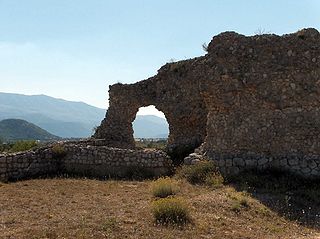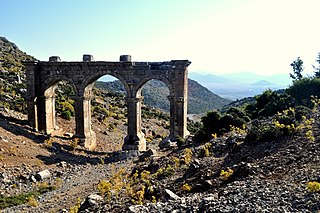Sources and external links
- Attribution
- This article incorporates text from a publication now in the public domain : Chisholm, Hugh, ed. (1911). "Aveia". Encyclopædia Britannica . Vol. 3 (11th ed.). Cambridge University Press. p. 52.
- GCatholic
Aveia was an ancient town of the Vestini and Roman former bishopric, which remains a Latin Catholic titular see.
Its site is on the Via Claudia Nova, c. 10 km south-east of L'Aquila, N.E. of the modern village of Fossa, in central Italy's Abruzzo region.
Some remains of ancient buildings still exist, and the name Aveia still clings to the place. The identification was first made by V. M. Giovenazzi in Della Città di Aveia ne' Vestini (1773). Paintings in the church of S. Maria ad Cryptas, of the 12th to 15th centuries, are important in the history of art. An inscription of a stationarius of the 3rd century, sent here on special duty (no doubt for the suppression of brigandage), was found here in 1902. [1]
The bishopric of Aveia (Vestina) was founded in the mid-5th century [2] (circa 450 AD) and disappeared, along with the town, in the 6th-century devastations of the Lombards, circa 500 AD.
Maximus of Aveia, a native of the town and a deacon, was martyred in the persecution of Decius, Roman Emperor from 249 to 251. The bishopric of Aveia may have arisen because of veneration of his relics. After the destruction of the town, these were removed to a nearby town which became known as Civitas Sancti Maximi (Saint Maximus Town), which thereupon became the seat of the diocese. From there, in 1256, they were moved to the new town and diocese of L'Aquila. [3] [4]
No longer a residential bishopric, Aveia is listed by the Catholic Church as [5] titular bishopric of Aveia since the diocese was nominally restored in January 2009.
Its only incumbent so far has been, of fitting episcopal (lowest rank) :

Aeclanum was an ancient town of Samnium, Southern Italy, about 25 km east-southeast of Beneventum, on the Via Appia. It lies in Passo di Mirabella, near the modern Mirabella Eclano.

Tindari, ancient Tyndaris or Tyndarion, is a small town, frazione in the comune of Patti and a Latin Catholic titular see.

Cannae is an ancient village of the Apulia region of south east Italy. It is a frazione of the comune (municipality) of Barletta, a former bishopric and presently a Latin Catholic titular see.

Amiternum was an ancient Sabine city, then Roman city and later bishopric and Latin catholic titular see in the central Abruzzo region of modern Italy, located 9 km (5.6 mi) from L'Aquila. Amiternum was the birthplace of the historian Sallust.
Aprus or Apros, also Apri or Aproi (Ἄπροι), was a town of ancient Thrace and, later, a Roman city established in the Roman province of Europa.

Remesiana was an ancient Roman city and former bishopric, which remains an Eastern Orthodox and also a Latin Catholic titular see, located around and under the modern city of Bela Palanka in Serbia.

Shahba is a city located 87 km (54 mi) south of Damascus in the Jabal el Druze in As-Suwayda Governorate of Syria, but formerly in the Roman province of Arabia Petraea. Known in Late Antiquity as Philippopolis , the city was the seat of a Bishopric, which remains a Latin titular see.

Amasra is a small Black Sea port town in the Bartın Province, Turkey, formerly known as Amastris.

Sarno is a town and comune and former Latin Catholic bishopric of Campania, Italy, in the province of Salerno, 20 km northeast from the city of Salerno and 60 km east of Naples by the main railway.

Peltuinum was a Roman town of the Vestini, on the ancient Via Claudia Nova, 20 km east of L'Aquila, Italy, between the modern-day settlements of Prata d'Ansidonia and Castelnuovo. It was apparently the chief town of that portion of the Vestini who dwelt west of the main Apennine chain. Remains of the town walls, of an amphitheatre, of a temple and of other buildings still exist. The city was the birthplace of Gnaeus Domitius Corbulo, a Roman general from the age of Nero.

Ariassus or Ariassos was a town in Pisidia, Asia Minor built on a steep hillside about 50 kilometres inland from Attaleia.

Aguilar, or in full Aguilar de la Frontera, is a municipality and town in the province of Córdoba, Andalusia, southern Spain, near the small river Cabra, 50 kilometres (31 mi) from the provincial capital, Córdoba, on the Córdoba-Málaga railway. As Ancient Ipagro, it also was an Ancient/medieval bishopric and remains a Latin Catholic titular see.

Hypaepa or Hypaipa was an Ancient city and (arch)bishopric in ancient Lydia, near the north bank of the Cayster River, and 42 miles from Ephesus, Ephesus and remains a Latin Catholic titular see.
Harpasa was a city and bishopric in ancient Caria in Roman Asia Minor, which only remains a Latin Catholic titular see.
Germanicopolis was an ancient town in Bithynia, also known as Caesarea in Bythinia (not to be confused with Caesarea Germanica, as such a former bishopric and present Latin Catholic titular see.
Icosium was a Berber city that was part of Numidia which became an important Roman colony and an early medieval bishopric in the casbah area of actual Algiers.

Tinja or Tindja (تينجة) is a town and commune (municipality) in the Bizerte Governorate, in northern Tunisia, on the shores of Lake Ichkeul. Its name derives from that of the ancient Roman era city of Thimida, a former bishopric which remains a Latin Catholic titular see.
Anineta, also known as Aninetum or Anineton, was a town of ancient Lydia or of Caria, and later of the Roman, and Byzantine empires, located in modern Turkey, the site of an ancient bishopric in and was an important site early in christianity. Anineta remains today a titular see of the Roman Catholic Church in the ecclesiastical province of Ephesus. In addition it minted coins bearing the legend Ἀνινησίων.

Castra Nova was a Roman-era city and diocese in Mauretania, Africa Proconsulare. The town is identified with the stone ruins at Mohammadia, Mascara in modern Algeria. It is now a Roman Catholic titular see.

Castra Severiana was an ancient Roman-era town of the Roman province of Mauretania Caesariensis, in North Africa during late antiquity.